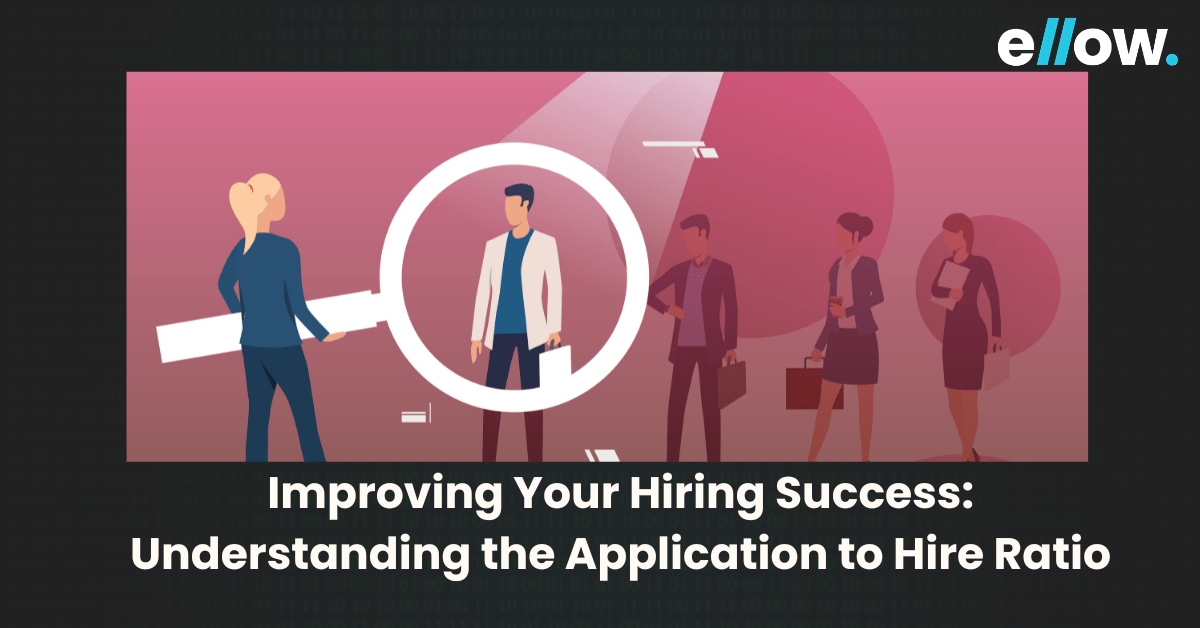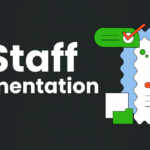We often hear the phrase, “It’s not about how many candidates you interview, but whether you’re getting them on board.” Recruiters would agree with this. No matter how many applications you receive, what truly matters is how many of those candidates you end up hiring.
The hiring process can be overwhelming, especially in fields like tech recruitment, which demands a lot of time, effort, and resources. According to a study by the Society for Human Resource Management (SHRM), the average time to hire a candidate can extend to 36 days. This prolonged timeline introduces various challenges, highlighting the need for recruitment efficiency.
One metric that can help streamline this process is the Application to Hire Ratio. This ratio shows how many applications you need to review before hiring. It’s a crucial indicator of the efficiency and effectiveness of your recruitment strategy.
This article will provide you with practical steps to improve your Application to Hire Ratio. Whether you’re developing a hiring strategy for startups or established companies, these tips are designed to be simple, effective, and easy to implement. Let’s explore how you can turn those applications into successful hires.
Understanding the Application to Hire Ratio
The Application Ratio is a key metric that organizations use to assess the effectiveness of their hiring process. This ratio measures the number of job applications received against the number of actual hires made.
Formula:
Application to Hire Ratio = Number of Applications / Number of Candidates Hired
A low Application to hire ratio might suggest that your company is struggling to attract qualified candidates or that there are inefficiencies in your recruitment process. This could result in a low conversion rate of applicants to hires.
On the other hand, a high ratio might indicate that your organization receives many applications but faces difficulties in finding suitable candidates or encounters challenges in the selection process.
Why Should You Care About Your Application to Hire Ratio?
Understanding and improving your Application to Hire Ratio can bring several advantages to your organization.
Advantages of a Lower Application to Hire Ratio:
- Reduced Time and Resources: A lower ratio means you spend less time filtering through unqualified candidates and more time focusing on top talent that fits your company culture and needs. This allows your team to focus on strategic initiatives and build strong relationships with promising candidates.
- Improved Candidate Experience: A high Application to Hire Ratio can lead to a negative candidate experience, where qualified individuals feel lost in the process. Attracting the right candidates ensures a more positive experience for everyone involved, strengthening your employer brand and increasing the likelihood of attracting top talent in the future.
- Potentially Higher Quality Hires: The best talent typically doesn’t need to apply to hundreds of jobs. With a targeted approach and a lower Application to Hire Ratio, you’re more likely to attract top candidates actively seeking the specific opportunity you’re offering. This can improve the quality of your hires, leading to better team fit and significant contributions to your company’s success.
- Faster Time to Hire: Every day a position remains unfilled, your company loses productivity and potential revenue. A lower ratio allows you to move qualified candidates through the hiring process more efficiently, getting them on board and contributing to your team faster.
- Reduced Cost per Hire: Hiring costs go beyond just salaries. They include the time and resources spent advertising the position, screening resumes, and interviewing candidates. A lower ratio helps streamline the process, potentially saving your company money in the long run.
Factors Affecting the Application to Hire Ratio
Several factors can influence your Application to Hire Ratio:
- Job Market Conditions and Industry Standards: Economic conditions and industry trends can affect the number of applicants and the quality of candidates. In a competitive job market, it may be more challenging to attract top talent.
- Quality of Job Postings and Descriptions: Clear, concise, and attractive job postings are more likely to attract qualified candidates. If your job descriptions are vague or overly complex, you might receive more applications from underqualified individuals.
- Employer Brand and Candidate Perception: A strong employer brand can attract top talent, while a weak brand might result in a higher number of unqualified applications.
- Screening and Interview Processes: Inefficient screening and interview processes can lead to a high Application to Hire Ratio. If your process is too slow or cumbersome, you might lose qualified candidates to other opportunities.
Strategies to Improve Your Application-to-Hire Ratio
Improving your Application to Hire Ratio requires a strategic approach. Here are some actionable steps:
- Enhance Job Descriptions: Ensure your job postings are clear, concise, and targeted. Highlight the key responsibilities, required skills, and what makes your company a great place to work. This will attract candidates who are genuinely interested and qualified for the role.
- Streamline the Application Process: Make the application process as smooth and user-friendly as possible. Avoid lengthy applications with irrelevant questions. Instead, provide clear instructions and ensure the process is mobile-friendly.
- Improve Screening and Selection Criteria: Refine your screening process to focus on the most relevant qualifications. Use pre-screening questions or assessments to filter out unqualified candidates early in the process.
- Leverage Technology and Recruitment Tools: Utilize applicant tracking systems (ATS) and other recruitment tools to automate repetitive tasks, such as resume screening. This allows you to focus on engaging with the most qualified candidates.
- Strengthen Employer Branding: Promote your company culture and values through social media, company websites, and employee testimonials. A strong employer brand can attract top talent and reduce the number of unqualified applications.
Monitoring and Adjusting Your Hiring Process
To maintain an optimal Application to Hire Ratio, it’s essential to regularly monitor and adjust your hiring process.
- Track Your Ratio: Regularly calculate your Application to Hire Ratio to identify trends and areas for improvement. This data will help you refine your recruitment strategies.
- Gather Feedback: Seek feedback from candidates and hiring managers to identify any pain points in the process. Use this feedback to make necessary adjustments.
- Adapt to Changes: Stay informed about industry trends and changes in the job market. Be prepared to adjust your hiring strategies accordingly.
How ellow.io Can Help You Improve Your Application to Hire Ratio
Improving your Application to Hire Ratio can be challenging, but ellow.io simplifies the process with its unique approach to talent acquisition. Here’s how ellow.io can help:
- Curated Talent Pools: ellow.io specializes in providing pre-vetted, highly skilled remote developers. By curating a talent pool that matches your specific requirements, ellow.io ensures that you’re only reviewing candidates who meet your criteria, reducing the number of irrelevant applications.
- Efficient Matching Process: With a focus on quality over quantity, ellow.io’s platform quickly connects you with top developers. This efficient matching process helps you save time and resources, improving your Application to Hire Ratio by presenting you with the right candidates from the start.
- Support Throughout the Hiring Process: ellow.io offers end-to-end support, from initial candidate sourcing to final hiring decisions. Their team of experts assists you in navigating the hiring process smoothly, providing insights and guidance to help you make the best choices for your team.
By leveraging ellow.io’s curated talent pools, efficient matching, and comprehensive support, you can significantly enhance your Application to Hire Ratio and streamline your recruitment process.
Conclusion
Improving your hiring process is essential for building a strong, efficient, and talented team. The Application to Hire Ratio is a powerful metric that can help you gauge and enhance the effectiveness of your recruitment strategy. A lower Application to Hire Ratio not only boosts your chances of securing high-quality hires but also enhances the overall candidate experience, strengthens your employer brand, and reduces recruitment costs.
If you need expert assistance in optimizing your recruitment process, consider partnering with ellow.io. With AI-powered matching, a seamless application process, and data-driven insights, ellow.io can help you achieve a supercharged Application to Hire Ratio and find the top talent your company deserves. Ready to transform your hiring process? Contact ellow.io today and start building a stronger, more efficient team!
FAQs
1. What is the Application to Hire Ratio?
The Application to Hire Ratio is a metric used to evaluate the efficiency of your hiring process. It measures the number of job applications received against the number of actual hires made. A lower ratio indicates a more efficient recruitment process, where fewer applications are needed to make a hire.
2. Why is the Application to Hire Ratio important?
This ratio is important because it provides insight into the effectiveness of your recruitment strategy. A lower ratio means you’re attracting more qualified candidates and spending less time filtering through unqualified applicants. It can also help you reduce hiring costs, improve candidate experience, and speed up the time to hire.
3. How can I improve my Application to Hire Ratio?
You can improve your Application to Hire Ratio by enhancing your job descriptions, streamlining your application and interview processes, leveraging technology like applicant tracking systems, and strengthening your employer brand to attract top talent.
4. What factors can affect the Application to Hire Ratio?
Several factors can influence this ratio, including job market conditions, the clarity of job postings, the strength of your employer brand, and the efficiency of your screening and interview processes.
5. How does ellow.io help improve the Application to Hire Ratio?
ellow.io helps improve your Application to Hire Ratio by providing curated talent pools of pre-vetted remote developers, streamlining the matching process to connect you with top candidates quickly, and offering end-to-end support throughout the hiring process.






